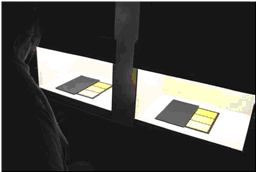
|
Context Sensitive Color Rendering from LED White Light |

|
Context Sensitive Color Rendering from LED White Light |
|
|
Faculty: Una-May O'Reilly
|
|
|
|
|
Figure 1: Contrast between high color rendering (right) and low color rendering (left).The brightness and color temperature of the two images are equal. |
|
LED efficiency can be increased by strategically adjusting the values of CR [4]. While adjustable light output (dimming) is well understood as an effective method to save energy in unoccupied spaces, LED lamp efficacy can be increased up to 30% by strategically lowering the color rendering. The notable point is that while modulating CR, the light level and CT can stay constant and therefore the appearance of the light source stays the same. How the objects are rendered under the light source is a key, ensuing question. If they can be rendered without noticeable change in quality, we could manipulate the lighting quality in a room without people noticing it. At no time would the space appear dark, uninviting or potentially unsafe (because light level (i.e. brightness) and CT are not changed). Additionally, if it were possible to smoothly transition between different CR modulations, it would not create any apparent distraction. Everyone wants good lighting. And, no one wants irritating lights that poorly respond to activity in a manner that is supposed to be "intelligent". Our hypothesis is that the most valuable intelligent lighting will be completely invisible.
Our first step toward this potential exploitation of context sensitive color rendering with white LEDs consists of an investigation of the perceptual impact of dynamic modulation of CR with color-mixing white LEDs. It allows us to understand if and how reduced CR would be acceptable for users. To date, we have conducted two rounds of psychophysical experiments during which observers evaluated a sequence of LED light settings and compare these to a reference source, an incandescent bulb. While we modulated Color Rendering, light levels and color temperature were held constant and the same as the reference source. We were able to demonstrate: (a) Perceived difference of different CRs; (b) Visual tolerance to reduced CR; (c) Correlation between reduced CR and various color reflectance (high and low saturation) to define ranges of colors that suffer the most from reduced CR.
We plan to follow up our booth experiments with a pilot study. We will ask the same questions concerning object rendering quality but we will manipulate the light in the context of a much more realistic everyday environment that has typical mixtures of color in the walls, furniture and objects. The results from our studies will provide us with guideline data (and a deeper understanding) that indicate human perceptual tolerance to color rendering manipulation. The data is essential in the design of a software control system with LED ceiling panel hardware, an LED actuation network and a sensor network to support novel energy saving lighting control strategies. Such a control system could achieve savings by intelligently linking the current activity in a space to the output from modular LED ceiling panels. It would incorporate distributed sensing algorithms to allow context sensitive modulation of light properties, particularly color rendering.

Figure 2: Subject facing illuminated booth openings and color charts.
Modulation of light quality properties (such as CRI) is still an open question in the field of solid state lighting. Our project was presented at the 6th Light Research Office Symposium in Light and Color, Lake Buena Vista, FL, February 2006 [6]. We receive support from Osram Sylvania who provided us with the LEDs.
References:
[1] F. Rubinstein. Long-Term Results from the Lighting Controls
Demonstration at the Watergate Building in Emeryville, CA. Final Report for
Pacific Gas and Electric Co., May, 1991. LBL Report LBL-28793.
[2] J. Schanda. The Concept of Color Rendering Revisited. Color in Graphics
Imaging and Vision. April 2002.
[3] M. S. Shur, A. Zukauskas. Solid State Lighting: Toward Superior
Illumination. Proc. IEEE, vol.93, NO. 10, pp.1691-1703, Oct. 2005.
[4] Y. Ohno. Color Rendering and Luminous Efficacy of White LED Spectra.
Proc. SPIE, vol.5530, Aug 2004.
[5] F. Schubert, J. K. Kim. Solid State Light Sources Getting Smart. Science
308, 1274-1278 (2005).
[6] M. Thompson, U.M. O'Reilly. An Investigation into the Perception of
Color under LED White Composite Spectra with Modulated Color Rendering.
Proceedings for the 6th Light Research Office Symposium in Light and Color,
Lake Buena Vista, FL, February 2006.